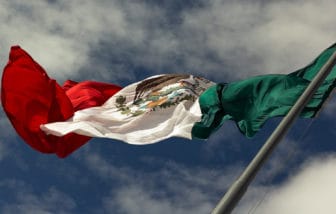Breaking a lull after the July 1 elections, violence with political overtones and ramifications has revisited Mexico. As July wore on, murders of elected and former candidates, journalists and human rights activists shattered the peace, the Mexican media reported.
On Tuesday, an ex-city council candidate for President-elect Andrés Manuel López Obrador’s Morena party was shot to death in Taretan, Michoacan. Enrique Equihua Sanchez had run for mayor of the town under the banner of the conservative National Action Party 12 years ago but more recently represented left-leaning Morena. And Alejandro Chavez Zavala, the mayor of Tartetan who was seeking re-election, was murdered on June 14.
Four days prior to Equihua’s slaying, two newly elected Morena officials were separately murdered in the states of Michoacan and Jalisco. In Buenavista, Michoacan, bullets claimed the life of Mayor-elect Eliseo Delgado Sanchez, while in the in the Guadalajara suburb of Tlaquepaque assassins cut down City Coucilman-elect Zenon Cocula Fierros.
The latest murders, all committed against individuals associated with Morena, occurred in areas with a presence of organized crime groups and ongoing bloodshed. Michoacan state Morena party leader Roberto Pantoja demanded that the state government put a halt to political violence.
The killings add to an earlier toll of more than 150 victims — candidates, ex-candidates, political party activists, family members and associates — who were murdered from the start of the election process last September through the first week of July, according to reports from the Etellekt private security firm and in the Mexican media. Virtually all of the politically-tainted homicides remain unpunished.
Journalists, too, were victims of renewed, post-election violence in July. On Monday, Luis Perez Garcia was found slain in his partially-burned home in the crime-ridden, Mexico City suburb of Iztapalapa. The 80-year-old journalist was also active in a neighborhood association, the alternative Mexican news site Desinformemonos reported.
Next day, Quintana Roo crime reporter and publisher Ruben Pat was killed by a gunman outside a bar located in the hip, international tourist destination of Playa del Carmen on the Caribbean.
According to the Apro news service, Pat’s publication, Playa News, was known for its extensive coverage of the deadly shooting at the Blue Parrot club in Playa del Carmen during a music festival in January 2017. The gunfire and resultant stampede snatched the lives of five people, four foreigners and a Mexican national, and injured 15 others.
Reportedly, Pat was under a special protection order granted to journalists and human rights defenders by the federal Interior Ministry when he was slain.
On June 29, two days before the elections, Playa News stringer Jose Guadalupe Chan Dzib was shot to death in a bar in Felipe Carrillo Puerto, a town situated in central Quintana Roo. Prior to their murders, both Chan and Pat had reportedly been threatened on multiple occasions.
The killings of Perez and Pat were strongly condemned by Mexican and Latin American journalists’ associations.
Moreover, the United Nations High Commissioner for Human Rights, the European Union and the Norwegian and Swiss embassies in Mexico expressed their deep concerns.
Quoted in Apro, the international officials urged the Mexican authorities to protect journalists in Mexico, and “carry out an adequate follow-up and evaluation of the protection protocol, with goal of having the greatest possible efficacy…”
The officials added that “the existence of a diverse, independent and free communications media is an indispensable condition for fostering and protecting democracy.”
In response to the Pat and Chan murders, the federal attorney general’s office declared on Wednesday that it would take charge of the respective investigations.
In a statement, the official National Human Rights Commission (CNDH) said it would lend support to the probe into Pat’s killing, adding that the murder brought the number of journalists killed in Mexico to eight in 2018 and 138 total since 2000. In addition, Oaxaca-based journalist Agustin Silva disappeared earlier this year and remains missing.
Besides signaling the “gravity of the situation and the risk that communicators in our country confront,” the CNDH said violence continues amid a lack effective measures by the three levels of government that would “curb the aggressions and the alarming impunity that surrounds them.”
Only days before the murders of Perez and Pat, the Mexico office of the United Nations High Commissioner for Human Rights had condemned the July 17 kidnapping and murder of Abraham Hernandez, regional coordinator of the Committee for Indigenous Rights (CODEI) in Oaxaca. Three members of the group were killed and a fourth injured in a Feb. 12 ambush in the southern Mexican state.
Following the Hernandez murder, the United Nations High Commissioner for Human Rights noted that eight human rights defenders had been killed so far this year in Mexico, half of them in Oaxaca.
A ninth victim, however, can now be added to the list. According to Desinformemonos, Oaxacan and national indigenous rights organizations are denouncing the Sunday slaying of community policeman and activist Rolando Crispin Lopez, who was gunned down in Juchitan by an individual some community members identified as a municipal policeman.
Demanding justice, the local community along with the National Indigenous Council and Zapatista-backed National Indigenous Council of Government held both the state and federal governments responsible for Cripsin’s murder because of “their incapacity of providing security to human rights defenders.”
The indigenous leaders blamed the murderous attack on an “offensive launched by governments and transnational companies” against the community of Alvaro Obregon, which is embroiled in a struggle to defend its territory from “invasion and destruction by wind energy megaprojects.”
Kent Paterson is an independent journalist who covers issues in the U.S./Mexico border region.
